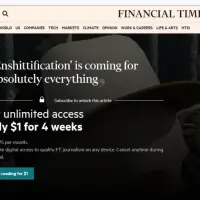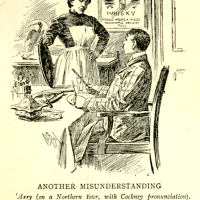 That’s right, Dominic Winter Auctioneers is putting a newly surfaced letter from C.S. Lewis on the auction block. It is a great artifact, as The Daily Mail reports, a generous and light bit of Narnian delight as Lewis answers some questions from schoolchildren at Grittleton House School in Wiltshire. The auctioneers have made photographs of this short, two-page 22 May 1952 letter. The children of Grittleton House–who Lewis calls Grittletonians–were no doubt curious after the release of The Lion, the Witch and the Wardrobe (1950) and Prince Caspian: Return to Narnia (1951). Not only did Lewis assure them that The Voyage Of The Dawn Treader (1952) would be out in a few months, but that there would be seven stories in all.
That’s right, Dominic Winter Auctioneers is putting a newly surfaced letter from C.S. Lewis on the auction block. It is a great artifact, as The Daily Mail reports, a generous and light bit of Narnian delight as Lewis answers some questions from schoolchildren at Grittleton House School in Wiltshire. The auctioneers have made photographs of this short, two-page 22 May 1952 letter. The children of Grittleton House–who Lewis calls Grittletonians–were no doubt curious after the release of The Lion, the Witch and the Wardrobe (1950) and Prince Caspian: Return to Narnia (1951). Not only did Lewis assure them that The Voyage Of The Dawn Treader (1952) would be out in a few months, but that there would be seven stories in all.
 Although the letter is very much like one sent to Michael Irwin just a couple of months previously (25 Mar 1952), there are a couple of things really worth noting here. There is, of course, Lewis’ characteristic humour and generosity of spirit to children. And as is usual for him, Lewis encourages the children to read well and write their own stories.
Although the letter is very much like one sent to Michael Irwin just a couple of months previously (25 Mar 1952), there are a couple of things really worth noting here. There is, of course, Lewis’ characteristic humour and generosity of spirit to children. And as is usual for him, Lewis encourages the children to read well and write their own stories.
But what is entirely new here? First, I believe this is the first time that we know there will be seven Narnian books. A year later, on 2 Mar 1953, Lewis will tell his publisher that there will only ever be seven Narnian stories. Second, this is I believe the first time that Lewis has used the phrase The Chronicles of Narnia to describe his work. He tends in articles and letters to say “Narnian books” or “Narnian stories.” It was Lewis’ friend and children’s author Roger Lancelyn Green who named the books, which is fitting considering how important he was to their creation.
 This is a good result from a new letter, considering how Lewis tended to follow a certain formula in his writing. It gives one hope about how many thousands of letters have never surfaced, and what may be in someone’s photo album or memory chest. Actually, it is almost a “too good to be true” discovery with more than 3,700 letters already in print, but the handwriting is authentic. Hopefully, the new owner will donate the piece to one of the C.S. Lewis archives or at least provide a high-quality copy for researchers. Or, perhaps you could own it–if you have enough $s or £s kicking around!
This is a good result from a new letter, considering how Lewis tended to follow a certain formula in his writing. It gives one hope about how many thousands of letters have never surfaced, and what may be in someone’s photo album or memory chest. Actually, it is almost a “too good to be true” discovery with more than 3,700 letters already in print, but the handwriting is authentic. Hopefully, the new owner will donate the piece to one of the C.S. Lewis archives or at least provide a high-quality copy for researchers. Or, perhaps you could own it–if you have enough $s or £s kicking around!
Following the Dominic Winter Auctioneers/PA photographs of the two-sided letter, I have provided a rough transcription of the letter. Where I have “and” may in some cases be an idiosyncratic ampersand (his stylistic plus sign). I am hoping tomorrow to dig into the details of the letter and provide a new timeline for the creation of Narnia. Thanks to friends in the Virtual C.S. Lewis Society for discovering it.
Magdalen College,
Oxford
May 22d. 1952
My dear Grittletonians—Thanks for your nice and interesting letters. Like you, I am sorry that Peter and Susan are not coming back to Narnia, but I think, being the two eldest, they are now getting to the age at which people stop having that sort of adventure for a time—they may start having it again later, but not for some years. The new book is called The Voyage of the Dawn Treader. Lucy and Edmund find Caspian (now King of course) on board ship, sailing to the Eastern end of the Narnian world. There will be lots about Reepicheep. And there will be a Sea Serpent, and a Dragon, and lots of strange islands. I do hope you will all like it. I intend to have seven of these stories altogether—that is, four more after the next one. They will be called The Chronicles of Narnia. The fifth sixth book goes right back to the beginning and explains how there came to be that magic Wardrobe in the Professor’s house—for of course you will have guessed that the old Professor must have known something about things like that himself, or else he would never have believed what the children told him. I don’t know yet what will happen in the seventh. What do you think would be a good thing to end the whole series with? Of course Aslan will come into them all.
I wonder what other books you all like. I like George MacDonald’s two Curdy books, and Tolkien’s The Hobbit, and The Wind in the Willows. Do you write stories yourselves? I did at your age: it is the greatest fun.
Love and good wishes to all,
yours ever
C.S. Lewis
P.S. E. Nesbitt’s books are splendid, I think: especially The Phoenix and the Wishing Carpet and The Amulet.
























Wow, thanks! – and thanks to Dominic Winter Auctioneers for taking the photos and making them available! Endearing to see him (not uncharacteristically?) mispelling someone’s surname…
Which one? Or did I misspell it?
He did: “Nesbitt” (never seen it in print with two ‘T’s!). I think he somewhere misspells Gervase Mathew’s surname in print. (Ach, I see I misspelt ‘misspelling’, myself!)
Misspell is a hard word not to misspell.
Pingback: Pixel Scroll 9/12/18 Pleonasmatic | File 770
Pingback: New Old Things from C. S. Lewis – Breathe
Pingback: A Timeline for the Creation of Narnia | A Pilgrim in Narnia
Thanks, Brenton. I’ll add it to my collection of Lewis’s Uncollected Letters (did I ever send you that?). I didn’t notice the double t in Nesbitt, and found no inaccuracies at all on your part – excepting one: in the final salutation the children merely get Lewis’s “good wishes”, not *all* good wishes.
Hi Arend, thanks for the transcription correction. Interesting error I made.
No, I don’t have a file of Uncollected letters, but would love to see it!
Great that such treasures are still being discovered and even make it into the news! The last sentence of the Daily Mail article mentions the auction date “The letter will be auctioned on September 12” – is it known how much it actually made and if it ended up in a private collection or a CS Lewis archive?
Well, there are about 6000 lost letters of Lewis out there, so uncovering new letters is definitely possible. Good letters, though, are going to be hard to find.
No results yet except “sold,” and will the media follow up?
6000? Whose estimate is that, or what is it based on?
Anyone, I’ll soon incorporate this new item into my compilation of letters and letter fragments and send you the result. It now has around 200 items, published and unpublished, from wherever I found them outside the Collected Letters – hence my designation “uncollected”.
Very cool, Arend, see below for my rationale about letters out in the world.
Sorry: for “Anyone” read “Anyway”.
I was also wondering how they know about those 6000; through cross references in other letters? But then there might also be info about the receivers and the letters would therefore be traceable?
Anyway, it would be better value-wise for them to only surface occasionally?
A totally presumptuous guess. Walter Hooper said somewhere he thought we had about 1/3 of letters, and based on the pace that people describe it could be more. Based on his own notes and complaints and letters, Lewis seemed to spend an hour or so in letters a day. And during the BBC talks he said he was responding constantly to letters. If you look at the letters we have, though, there are 3,274 by my count published. During WWII he was writing at a pace of 40-60 letters per year, or 40-80 pages per year. The exception is 1940 when he wrote long letters to Warren. At a rate of 4 pages per hour (and in the published version Lewis could have written 5 or 6 as most are small notes), it means Lewis only spent 10-20 hours most years writing letters.
So, out there in the world, I think there are at least 6,000 letters, mostly short. There could be more like 10,000 including short postcard-like notes.
As far as I recall, the late John Christopher wrote in an article, and talked in my interview with him for the Wade, about having written Lewis with (I think it was) some youthful comment about one of the Ransom books, and receiving in reply a postcard with “Thank you for writing. There may be something in what you say” or words to that effect – and saying that he later learned this was a fairly standard response by Lewis. So, there may be a lot of those out there… (I’d save it, if I’d gotten one!)
Yes, I suspect there are 100s of those babies out in the world (mostly in compost form now, but some in shoeboxes and photoalbums.
Ah, so by mathematical deduction – that makes sense! Such very prolific letter writing and giving us so much insight into his creative thinking process …
What might a current equivalent be – a collection of blog pages with comments, or emails? Most tweets and chats will probably dissolve in digital space? Your letter compost at least fertilises plants …
We got some fine-line food-colouring pens once, so safely edible rice-paper letters are a possibility (barring any allergies to colouring or rice)…
Good question! I don’t know, but a normal year of emails I receive would be 3000-5000, sending perhaps 1500-2000. So “prolific”…. not sure. Social media poster?
What is certainly true is that future historians will have a much different job than past historians.
Yes, their job will surely be different, also because of all the web links that may/will be ‘fading’ as well and with that access to our digital ‘libraries’?
Is ‘prolific’ the right word? I checked it and it seemed ok, but maybe not in this context?
Or do you mean that all those emails will not amount to a prolific output as they are so different from letters? And what do you mean by a social media poster?
A lot of differences, I think. If you become famous and pass on your literary remains, your researchers will get a hard drive full of data of access to the could. Plus you have digital footprints in a hundred places. Perhaps you’ll have 400,000 “writings” in 4,000 different formats by the time you move on too greater lands. See the issue? Before it was a few boxes of papers, if we were lucky.
Yes, exactly. That hard drive is at least something more solid, but access to all those digital footprints (and cloud storage) … would web links still be there in some 50 years? I never could get used to paper free offices.
But might it also be something typical of our times? Eg in architecture, these days a building is considered old at 30 and in need of being replaced, while at least here in Europe buildings are still there from many hundreds of years ago?
PS Further to those ‘paper free offices’: in the years before my retirement I developed a complex digital storage system for the research results of my department from huge research programs, funded by the EU and the Dutch government, and many smaller projects. There are archival ways and systems to safeguard those results, but for me paper archival systems remained a lot safer.
in short, being a Digital Leopard Frog?
I must say I (reading them for the first time as an undergraduate English major – or was it even later?: i know my roommate devoured my boxed set before I attempted any…) never “guessed that the old Professor must have known something about things like that himself, or else he would never have believed what the children told him” – I supposed he was just being open-mindedly rational, etc.! Lewis may say something to this effect in MN or elsewhere, but it still rather surprises me reading it, here – seeming to give (somebody like) “the old Professor” too little credit. (But then I grew up reading Fortean cryptozoologists, and such like…)
Yeah, me too! I never guessed that Prof. K was Digory until I read MN.
I am almost ridiculously pleased that Lewis liked The Wind in the Willows. I wonder why… Apart from the fact that I love it myself.
It’s a nice connection. Elsewhere Lewis references it, “On Stories” essay I believe. But I don’t think he read the book as a kid, but later as an adult. I like it better myself now, finding it kind of random as a kid.
It is random, isn’t it? I think that I read it almost as a collection of stories as a child, even as a collection of tableaux. I don’t think that I minded. Each one was beautiful just as Lucy’s first meeting with Mr Tumnus by a lamppost is beautiful and does, just as Lewis intends it to, carries you further on and further in.
Pingback: Inklings Graves in Oxford | A Pilgrim in Narnia
Pingback: (Re)Considering the Planet Narnia Thesis | An Unexpected Journal
Pingback: “(Re)Considering the Planet Narnia Thesis”: My Article in An Unexpected Journal | A Pilgrim in Narnia
Pingback: Girls, Boys, and the Maps in Their Heads | A Pilgrim in Narnia
Pingback: How do you Solve a Problem like Susan Pevensie? Narnia Guest Post by Kat Coffin | A Pilgrim in Narnia
Pingback: “The Once and Forgotten T.H. White: What happened to him?” by G. Connor Salter | A Pilgrim in Narnia
I have my note from Lewis framed, but I gave a Xerox to the Wade. One of these years–real soon now, as I say–I’ll publish the essay in which it’s appropriate to quote it.
That’s awesome, Joe–all three parts: the framed note, the donation, the potential essay.
bd
Pingback: A Garden Gate Summer Note on Teaching and the First Days of School | A Pilgrim in Narnia